Page 547 of 704
547 4-3. Do-it-yourself maintenance
4
Maintenance and care
YARIS_F (including HV)_WE_52C79ETurn the bulb base counterclock-
wise.
Remove the light bulb.
When installing, reverse the steps listed.
License plate lights
Remove the cover.
Insert a properly sized screw-
driver into the hole of the cover,
and ply off the cover as shown in
the illustration.
To prevent damaging the vehicle,
wrap the screwdriver with a tape.
Page 548 of 704
548 4-3. Do-it-yourself maintenance
YARIS_F (including HV)_WE_52C79ERemove the light bulb.
When installing, reverse the steps listed.
Replacing the following lights
If any of the lights listed below has burnt out, have it replaced by
any authorized Toyota dealer or repairer, or another duly qualified
and equipped professional.
Front position lights and daytime running lights (LED type)
Stop/tail lights (LED type)
High mounted stoplight
Page 549 of 704
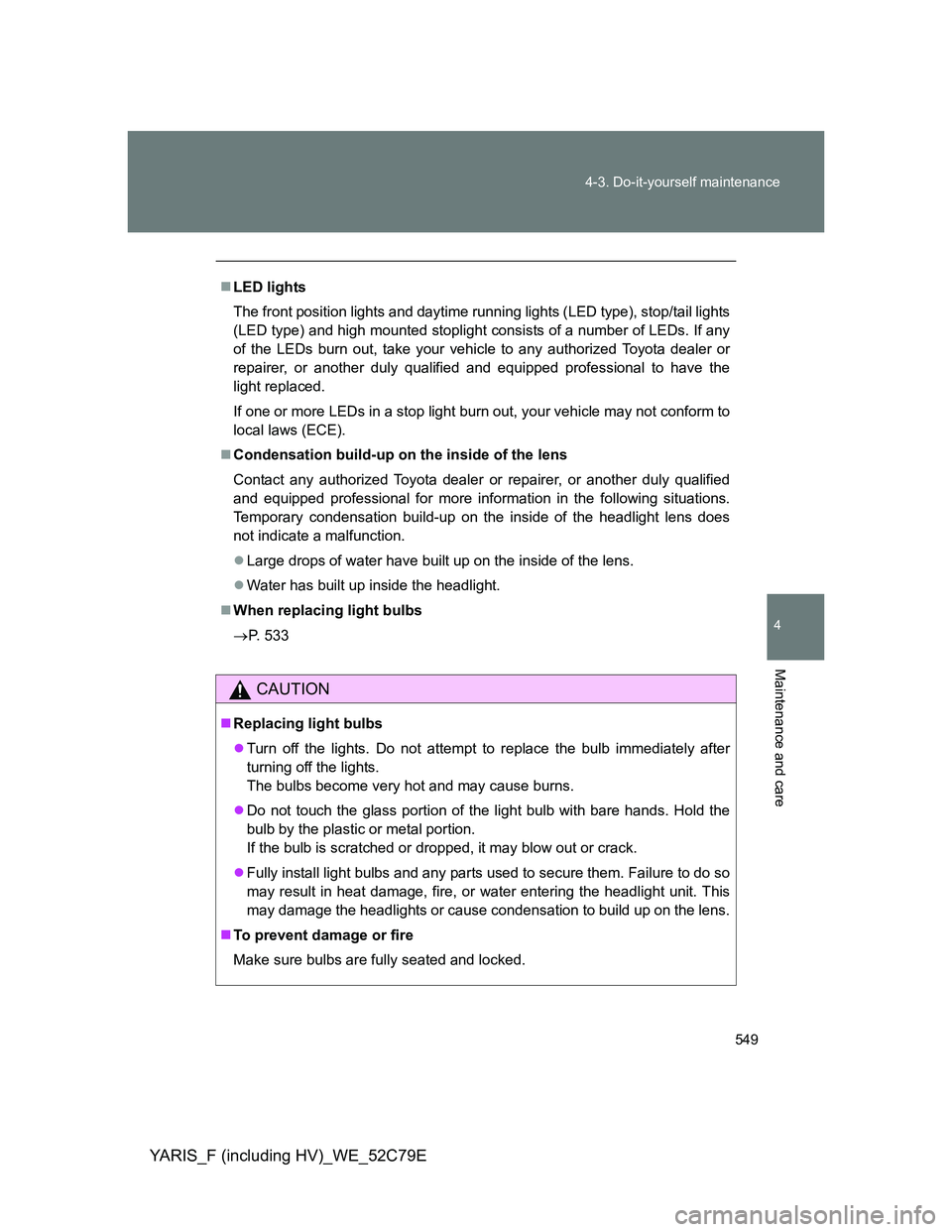
549 4-3. Do-it-yourself maintenance
4
Maintenance and care
YARIS_F (including HV)_WE_52C79E
LED lights
The front position lights and daytime running lights (LED type), stop/tail lights
(LED type) and high mounted stoplight consists of a number of LEDs. If any
of the LEDs burn out, take your vehicle to any authorized Toyota dealer or
repairer, or another duly qualified and equipped professional to have the
light replaced.
If one or more LEDs in a stop light burn out, your vehicle may not conform to
local laws (ECE).
Condensation build-up on the inside of the lens
Contact any authorized Toyota dealer or repairer, or another duly qualified
and equipped professional for more information in the following situations.
Temporary condensation build-up on the inside of the headlight lens does
not indicate a malfunction.
Large drops of water have built up on the inside of the lens.
Water has built up inside the headlight.
When replacing light bulbs
P. 533
CAUTION
Replacing light bulbs
Turn off the lights. Do not attempt to replace the bulb immediately after
turning off the lights.
The bulbs become very hot and may cause burns.
Do not touch the glass portion of the light bulb with bare hands. Hold the
bulb by the plastic or metal portion.
If the bulb is scratched or dropped, it may blow out or crack.
Fully install light bulbs and any parts used to secure them. Failure to do so
may result in heat damage, fire, or water entering the headlight unit. This
may damage the headlights or cause condensation to build up on the lens.
To prevent damage or fire
Make sure bulbs are fully seated and locked.
Page 552 of 704
552
YARIS_F (including HV)_WE_52C79E
5-1. Essential information
Emergency flashers
Emergency flashers
Except hybrid vehicle: If the emergency flashers are used for a long time
while the engine is not operating, the battery may discharge.
Hybrid vehicle: If the emergency flashers are used for a long time while
the hybrid system is not operating (while the “READY” indicator is not illu-
minated), the 12-volt battery may discharge.
The emergency flashers are used to warn other drivers when the
vehicle has to be stopped in the road due to a breakdown, etc.
Press the switch.
All the turn signal lights will
flash. To turn them off, press
the switch once again.
Page 565 of 704
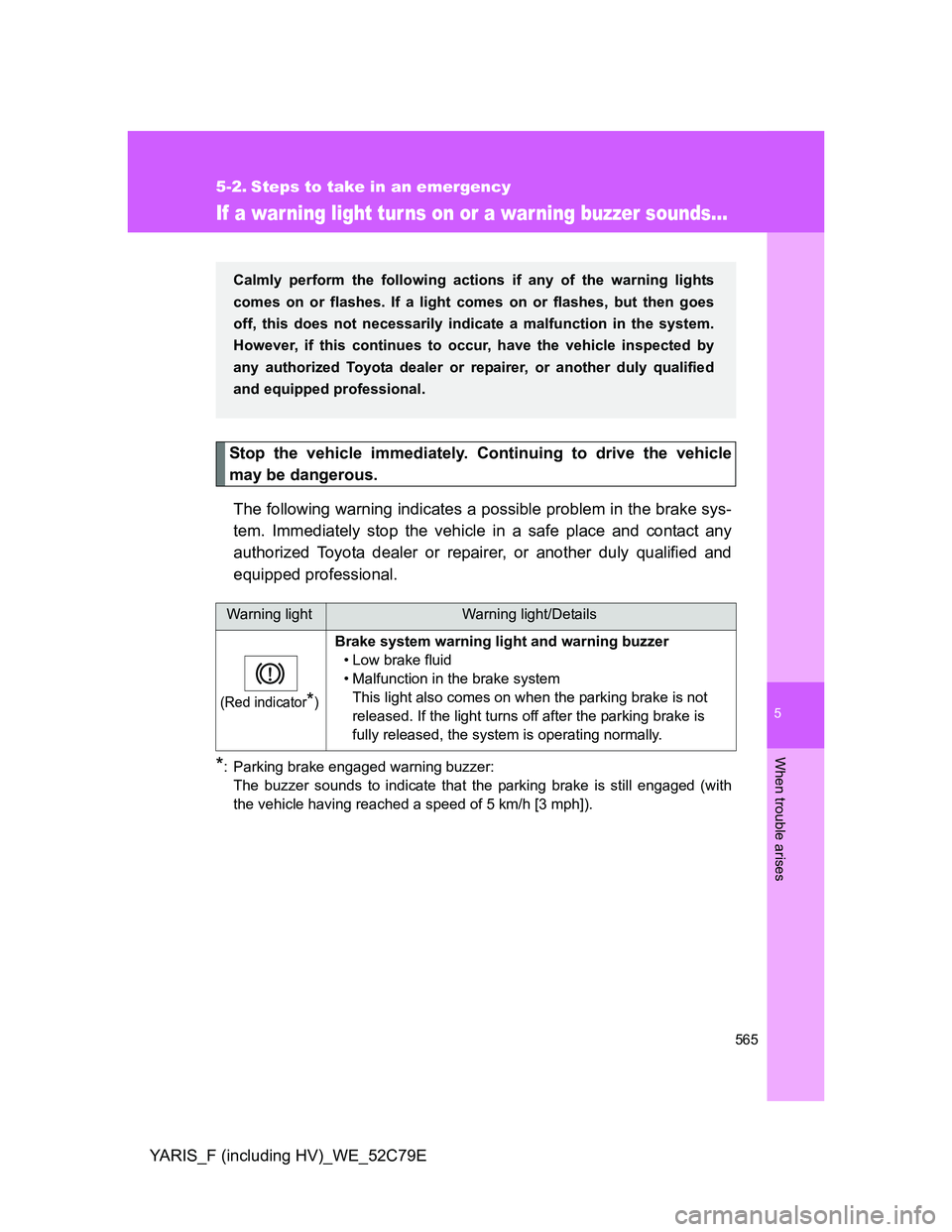
5
565
When trouble arises
YARIS_F (including HV)_WE_52C79E
5-2. Steps to take in an emergency
If a war ning light tur ns on or a warning buzzer sounds...
Stop the vehicle immediately. Continuing to drive the vehicle
may be dangerous.
The following warning indicates a possible problem in the brake sys-
tem. Immediately stop the vehicle in a safe place and contact any
authorized Toyota dealer or repairer, or another duly qualified and
equipped professional.
*: Parking brake engaged warning buzzer:
The buzzer sounds to indicate that the parking brake is still engaged (with
the vehicle having reached a speed of 5 km/h [3 mph]).
Warning lightWarning light/Details
(Red indicator*)
Brake system warning light and warning buzzer
• Low brake fluid
• Malfunction in the brake system
This light also comes on when the parking brake is not
released. If the light turns off after the parking brake is
fully released, the system is operating normally.
Calmly perform the following actions if any of the warning lights
comes on or flashes. If a light comes on or flashes, but then goes
off, this does not necessarily indicate a malfunction in the system.
However, if this continues to occur, have the vehicle inspected by
any authorized Toyota dealer or repairer, or another duly qualified
and equipped professional.
Page 570 of 704
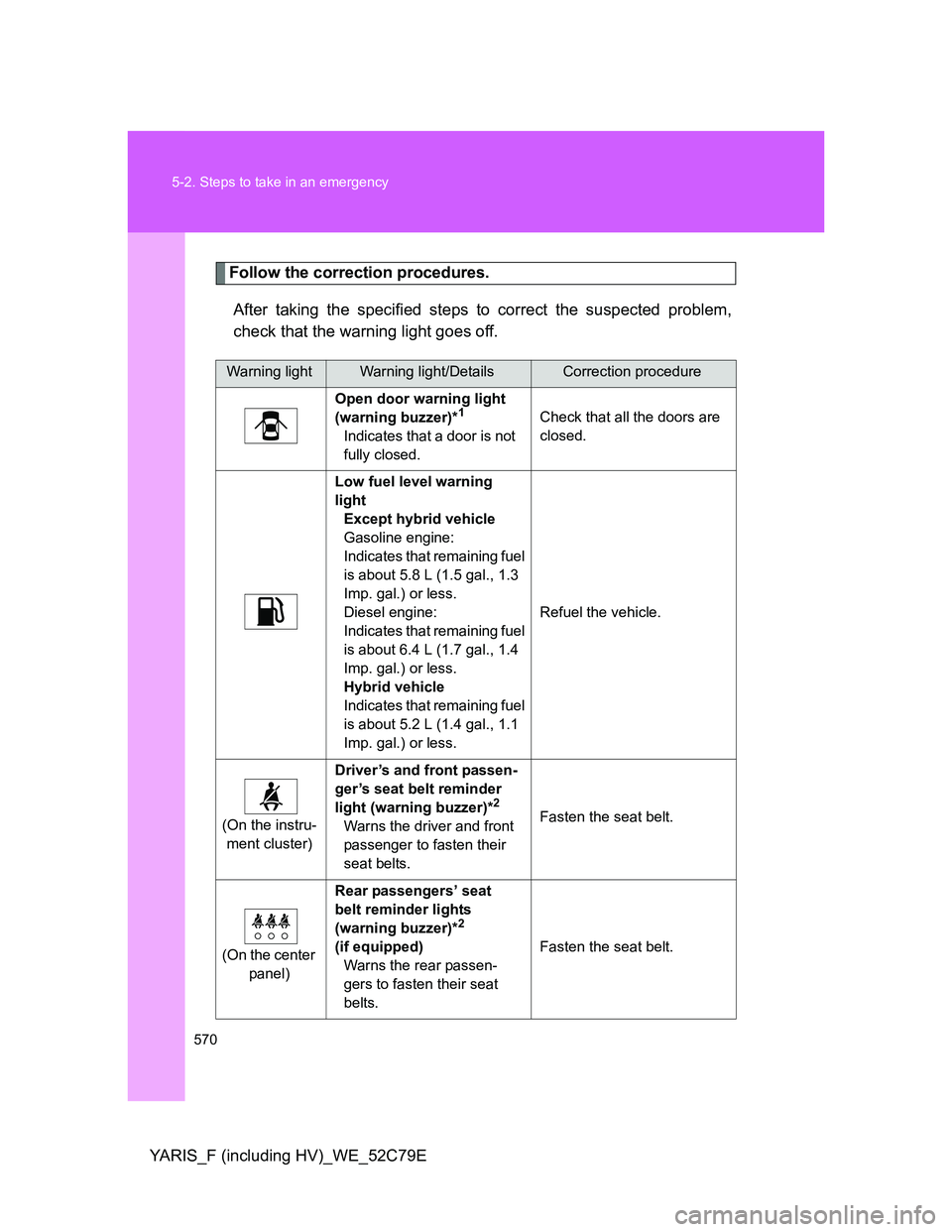
570 5-2. Steps to take in an emergency
YARIS_F (including HV)_WE_52C79E
Follow the correction procedures.
After taking the specified steps to correct the suspected problem,
check that the warning light goes off.
Warning lightWarning light/DetailsCorrection procedure
Open door warning light
(warning buzzer)*
1
Indicates that a door is not
fully closed.Check that all the doors are
closed.
Low fuel level warning
light
Except hybrid vehicle
Gasoline engine:
Indicates that remaining fuel
is about 5.8 L (1.5 gal., 1.3
Imp. gal.) or less.
Diesel engine:
Indicates that remaining fuel
is about 6.4 L (1.7 gal., 1.4
Imp. gal.) or less.
Hybrid vehicle
Indicates that remaining fuel
is about 5.2 L (1.4 gal., 1.1
Imp. gal.) or less.Refuel the vehicle.
(On the instru-
ment cluster)Driver’s and front passen-
ger’s seat belt reminder
light (warning buzzer)*
2
Warns the driver and front
passenger to fasten their
seat belts.Fasten the seat belt.
(On the center
panel)Rear passengers’ seat
belt reminder lights
(warning buzzer)*
2
(if equipped)
Warns the rear passen-
gers to fasten their seat
belts.Fasten the seat belt.
Page 611 of 704
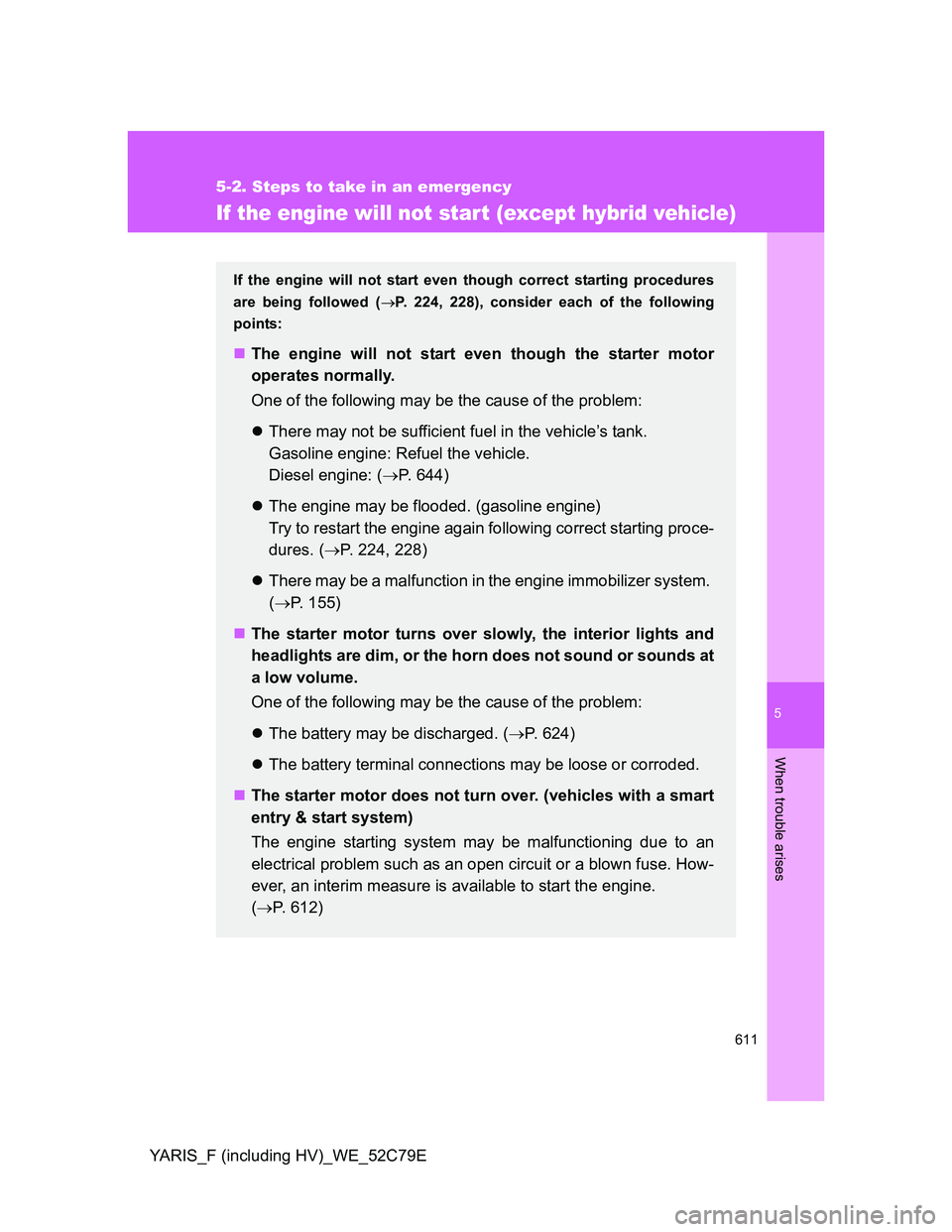
5
611
5-2. Steps to take in an emergency
When trouble arises
YARIS_F (including HV)_WE_52C79E
If the engine will not start (except hybrid vehicle)
If the engine will not start even though correct starting procedures
are being followed (P. 224, 228), consider each of the following
points:
The engine will not start even though the starter motor
operates normally.
One of the following may be the cause of the problem:
There may not be sufficient fuel in the vehicle’s tank.
Gasoline engine: Refuel the vehicle.
Diesel engine: (P. 644)
The engine may be flooded. (gasoline engine)
Try to restart the engine again following correct starting proce-
dures. (P. 224, 228)
There may be a malfunction in the engine immobilizer system.
(P. 155)
The starter motor turns over slowly, the interior lights and
headlights are dim, or the horn does not sound or sounds at
a low volume.
One of the following may be the cause of the problem:
The battery may be discharged. (P. 624)
The battery terminal connections may be loose or corroded.
The starter motor does not turn over. (vehicles with a smart
entry & start system)
The engine starting system may be malfunctioning due to an
electrical problem such as an open circuit or a blown fuse. How-
ever, an interim measure is available to start the engine.
(P. 612)
Page 612 of 704
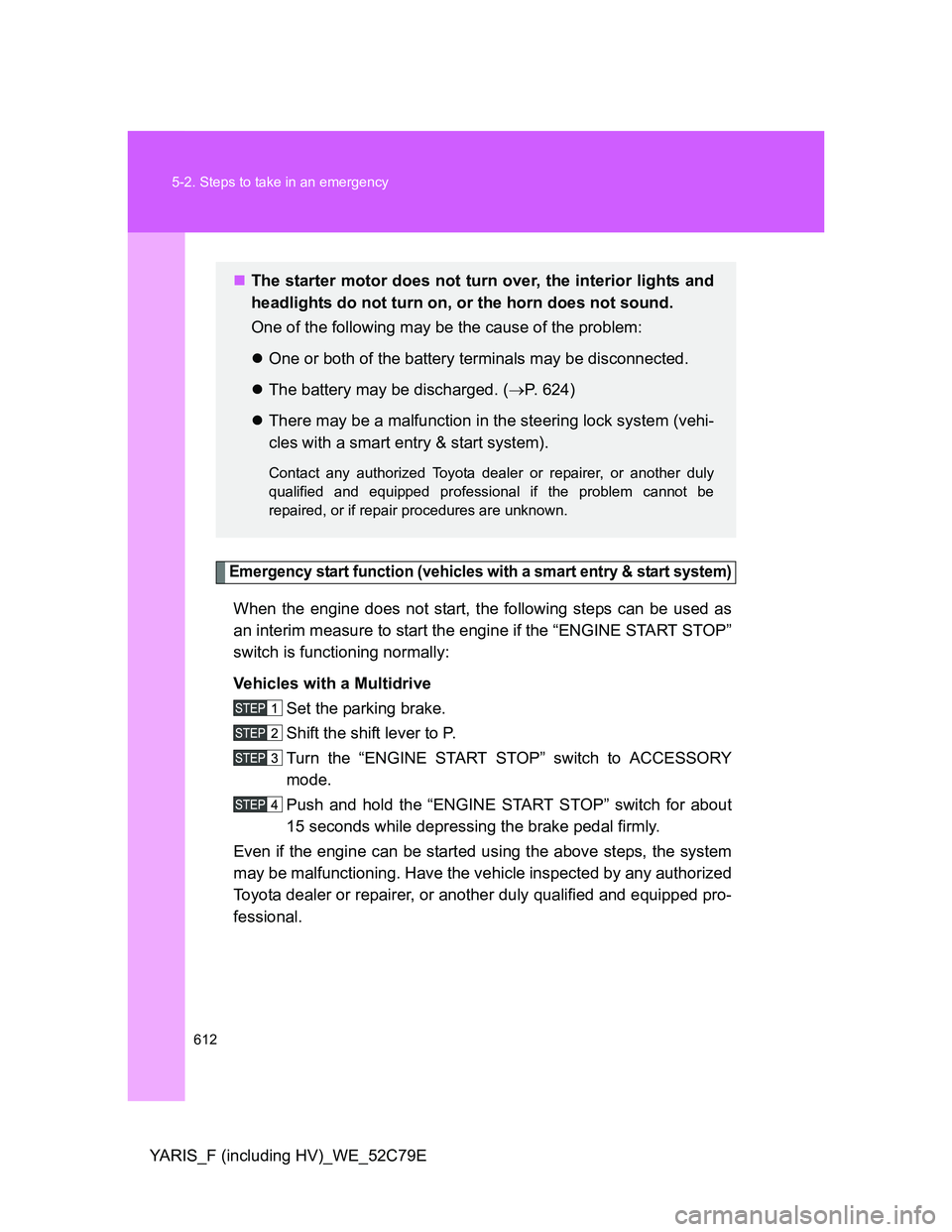
612 5-2. Steps to take in an emergency
YARIS_F (including HV)_WE_52C79E
Emergency start function (vehicles with a smart entry & start system)
When the engine does not start, the following steps can be used as
an interim measure to start the engine if the “ENGINE START STOP”
switch is functioning normally:
Vehicles with a Multidrive
Set the parking brake.
Shift the shift lever to P.
Turn the “ENGINE START STOP” switch to ACCESSORY
mode.
Push and hold the “ENGINE START STOP” switch for about
15 seconds while depressing the brake pedal firmly.
Even if the engine can be started using the above steps, the system
may be malfunctioning. Have the vehicle inspected by any authorized
Toyota dealer or repairer, or another duly qualified and equipped pro-
fessional.
The starter motor does not turn over, the interior lights and
headlights do not turn on, or the horn does not sound.
One of the following may be the cause of the problem:
One or both of the battery terminals may be disconnected.
The battery may be discharged. (P. 624)
There may be a malfunction in the steering lock system (vehi-
cles with a smart entry & start system).
Contact any authorized Toyota dealer or repairer, or another duly
qualified and equipped professional if the problem cannot be
repaired, or if repair procedures are unknown.